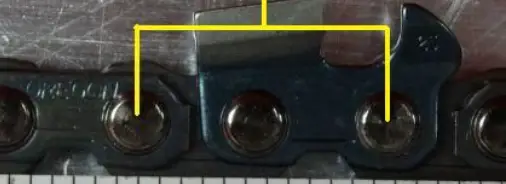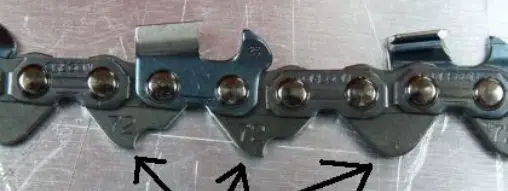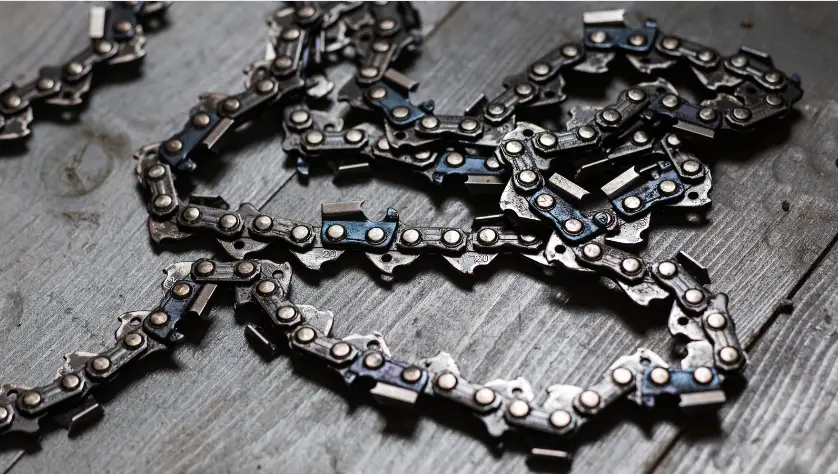Chainsaw chains are probably the most complicated part of a chainsaw when it comes to buying a replacement part. Not only do you need to find the matching chainsaw chain in the store in terms of the chain size, you’ve got chain pitch, chain gauge, and drive links to worry about too.
To make things even more complicated, there’s a whole range of different chainsaw chain types with different features and aggression levels, so finding the correct chain is no easy task.
Whilst we can’t cover everything in great depth today (our main focus is chainsaw chain size here), we will briefly discuss aggressive chains and chainsaw chain features to give you an idea of what’s out there, but this won’t be the main focus.
If you’re only here because you’re concerned about getting the right size chainsaw chain, though, then you’re in the right place!
Why Getting Your Chain Size Right Is Vital
Matching chainsaw chains to your chainsaw bar length and chainsaw model is so important. If you don’t get the correct chainsaw chain, then the power tool you’re using is going to be either A) no longer safe to use, or B) no longer good at its job.
The wrong chain size could mean your chainsaw ends up crooked, making any woodworking project you’re carrying out a nightmare.
In order to get the right chainsaw chain, you need to follow a few chain matching search steps that will help you along the way…

Things To Look Out For When Buying A Replacement Chain
Professional users will already know how to measure a chainsaw chain to get the right one when replacing it, but for us novices, it’s not so easy.
Thankfully, there are just three measurements you need to be aware of:
- chain pitch
- chain gauge
- number of drive links
Most chain manufacturers will list this on the packaging of a new chain, so armed with this information, you’ll be able to find the right chainsaw chain for your chainsaw!
Finding The Chainsaw Chain Measurements You Need
For ease, many chain manufacturers will include two of the three measurements you require in the chainsaw user manual so you can replace your chain with the right chainsaw chain for your model without fuss.
However, that becomes something of an issue when you’ve thrown out your owner’s manual and can’t find your model number to look it up online.
But don’t worry, all is not lost.
You can measure any chainsaw chain with ease by focusing on the pitch, gauge, and drive links – and below, we’ll tell you how to measure all three on your old chain so your new one will be the right chain!
How To Measure Chainsaw Chains
Knowing your chain length and size is slightly more complex than finding your chainsaw bar length and size (you can read our article about chainsaw bar length on our website, if you need to know your bar length as well).
However, all you need is your existing chain, a tape measure, a calculator, callipers, and a notebook to jot down your measurements. With this, you’ll be able to work out the right chainsaw chain size for you.
Chain Pitch Measurement
Let’s start with the chainsaw chain’s pitch measurement. The pitch refers to how close the drive links are to one another in the chain. Generally speaking, the closer the cutting teeth or drive links are to one another, the less power is needed to cut through the wood. In contrast, the further apart the cutting teeth or drive links, the more power is needed and the more aggressive the chain is.
Getting the measurement wrong could mean putting a chain on your chainsaw with a pitch that’s either not strong enough, or far too strong for your projects.

Locating The Measurement
Most chainsaw manufacturers will list the chain pitch measurement either in the user manual or on the chainsaw itself – typically at the user end of the guide bar. If you see any of the following measurements on your guide bar, then the chances are it’s the pitch measurement:
- 1/4 inch
- 0.325 inch
- 3/8 inch
- 3/8 inch (low profile chain)
- 0.404 inch
The most common pitch measurement is 3/8 inch, which is often found on chainsaws you use at home (smaller pitches are reserved for more accurate, finer cutting, and larger pitches are for powerful chainsaws used by professionals). However, not every at-home chainsaw has a 3/8 inch pitch, so you can’t just rely on a ‘best guess’. If the pitch measurement isn’t clearly displayed on the guide bar or in the manual, then you will need to have it measured.
Measuring Yourself
Chainsaw users aren’t usually advised to measure the pitch themselves, because it requires a high level of accuracy (the difference between a 3/8 inch pitch and a 0.325 inch pitch may not be huge, but their light-years apart in terms of chainsaw chains).
If you don’t feel comfortable, you can take your chainsaw to a shop and have them measure the pitch for you, so you get the right replacement. If you’re confident, however, you can measure it by simply:
- Measuring the distance accurately between the middle points of any three rivets on the chain
- Divide the distance by two
- And then you have your pitch measurement
Chain Gauge Measurement
Drive links fit into the guide bar and help keep the chain in place. The chain gauge measurement looks at the thickness of these drive links as you look at them along the length of the chain.
It’s vital that this measurement be right, or else a chain gauge measured incorrectly will lead to drive links that don’t fit the guide bar, and a chainsaw that can’t operate effectively.
Locating The Measurement
Just as with the pitch, your gauge measurement ought to be listed in the owner’s manual or on the guide bar at the user end. And again, just as with the pitch, your gauge measurement will be recorded in inches. If any of the following measurements are something you notice on your guide bar, then it’s probably your gauge chain measurement:
- 0.043 inch
- 0.050 inch
- 0.058 inch
- 0.063 inch
Again, there is a most common gauge you’ll find on a typical or normal chain, but you can’t rely on that always being the case. 0.050 inch-gauges are the most common though, so it’s worth keeping that in mind just as extra reassurance that you’re on the right track.
If the gauge isn’t clear on the chainsaw guide bar or in the user’s manual, then you will need to measure it yourself.
Measuring It Yourself
It’s not recommended that users measure gauge themselves, because as you can see from the gauge measurements listed above, there is very little margin for error. However, with the right tool, it isn’t too difficult.
Unfortunately, not many people have callipers at home to use for jobs like this, which is why it’s usually recommended that you take it to a shop where professionals can check the gauge for you. But if you do have callipers, then you can be incredibly accurate and get a great gauge reading without needing it to be written on your chainsaw guide bar or have someone else do it for you.
Simply use your callipers to measure the thickness of the drive links to get an accurate reading, keeping the example gauge measurements listed above in mind to ensure you’re accurate.
Number Of Drive Links
Finally, the third measurement you’ll need to get the right chain size is the number of drive links. This simply refers to the total number of drive links around the entire chain – every single one of them – drive link after drive link.
If you get this measurement wrong, then you’ll end up with a chain that’s too big or too small for your guide bar and chainsaw, meaning it won’t fit at all or will be too loose when cutting, resulting in wonky cuts.

Locating The Measurement
Unfortunately, a drive link count won’t be listed on your guide bar or in the user manual like with the other two measurements today, which means chainsaw users face counting your chain’s drive links themselves to get the number they need.
There aren’t any average drive link counts to give you here either, we’re afraid, because most regular chains have different drive link counts between each manufacturer, so there’s only one thing left to do…
Measuring It Yourself
That’s right! You’ll need to count each drive link on your existing chain yourself to get the chain length drive link number you need.
All we can advise for this one is that you mark your first drive link clearly with tape or a sticker, before counting round the rest of them until you reach the first one again.
Because this number is so important, we’d recommend asking a friend or family member to count after you have to make sure you get the same number. If you do, you can be confident that you’ve got the right amount.
Matching Your Measurements To The New Chainsaw Chain
Now that that’s all over with, you should have three measurements that will tell you the chainsaw chain length you need to buy at the store.
Thankfully, the hardest part is done – all you need to do now is compare chainsaw chains to your numbers (they’ll have their three relevant measurements listed clearly on the front) and then pick out the chainsaw chain that matches yours.
That way, you can be certain that the new chain has the same measurements as your existing chain and will fit your chainsaw perfectly.
A Few Notes On Chain Types
Before we finish, let’s just touch on chain types. It’s important to know that there are different chain types out there and what they do, but this isn’t an in-depth look at them, rather just a small section to bring the main three types of chainsaw chain to your attention so you know what’s out there when purchasing a new chainsaw chain.
- Low-profile chains – a low profile chain has smaller cutters than a standard chainsaw chain, meaning low profile chains leave shallower cuts in wood. They’re lighter as a result, and put less strain on engines. Typically, they have a 3/8 inch pitch, 0.050 inch gauge, and 72 drive links.
- Narrow kerf chains – a narrow kerf chain has narrower cutters than a standard chainsaw chain, meaning narrow kerf chains leave a narrower cut in wood, allowing it to cut quicker and take out less wood, perfect for electric saws that need to move fast. These chains fit very specific chainsaw models with a narrow kerf design bar, so if you don’t have this, don’t buy these chains.
- Ripping chains – a ripping chain cuts at a lower angle than a standard chainsaw, meaning it is much better suited to heavy duty tasks, where cutting along the grain rather than against it is important (like with logging and milling). They come in a range of pitch, gauge, and drive link sizes, but are only designed for very specific heavy duty tasks.
A Few Notes On Chain Aggressiveness
Likewise, knowing a little about chain aggressiveness will help you understand what more aggressive chains do compared to less aggressive ones, but this isn’t the focus today. To touch on it…
- Low kickback chains – a low kickback chain is designed to lessen the chance of a kickback (where the chainsaw guide bar hits the material you’re cutting and sends the chainsaw back in your direction – a dangerous situation to be in). These chains are for chainsaws that have lower power and are designed for less heavy duty work. Most at-home chainsaws will use these chains.
- Skip tooth chains – a skip tooth chain is basically your everyday chain. If the manufacturer doesn’t list any specific chain features under their power tool accessory information (like low kickback or full skip) then it’s likely just a bog standard skip tooth chain.
- Full skip chains – a full skip chain is the most aggressive and is much less safe to use than a low kickback chain. As a result, these chains are reserved for professional, trained users only.
A Few Notes On A Chain’s Features
Finally, here are some cool chain features to look out for. If you’re unsure if they’re the right chainsaw chains for you, talk with a saw shop worker for more information. Again, these features aren’t the focus, but they’re good to keep in mind when shopping for a new chain.
- Self sharpening chainsaw chains – you guessed it, self sharpening chains have self sharpening chain features that grind the teeth as the chain passes around the guide bar and through a self sharpening unit.
- Self lubricated chainsaw chains – another obvious one, this feature helps keep chains lubricated by maintaining proper lubrication due to holes in cutting links that store oil and keep everything lubricated.
- Low vibration chains – a low vibration chain is amazing, because chainsaw vibration can cause health issues. Some chains are designed with features to reduce vibration, such as a space between the guide bar and chain to lessen vibration. This feature is important if you use chainsaws regularly.
- Ripping chains – these chains are, again, for the professionals only.
- Carbide chains – although less sharp and slower, carbide chains are used when durability is important, because carbide is a material that doesn’t wear down easily. They cost more than standard chains, though, so this is best left to professionals who need a reliable chain for longer.
Final Thoughts
Picking the right chainsaw chain can be difficult, but if you keep in mind the three measurements you need to get the correct chain size, then you’ve already won half the battle. The features, types, and aggressiveness of the chain really don’t matter as much, and can all be worked out with a professional in store to ensure you get the chain that’s right for you.
Nail those three measurements – pitch, gauge, and drive link count – though, and you’ll find shopping for a new chain to be much less stressful!


